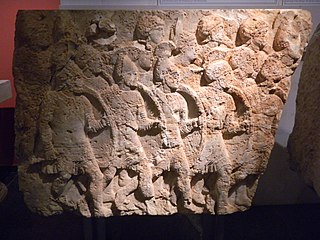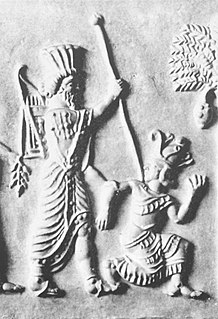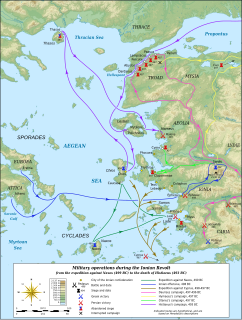 W
WAbdashtart I was a king of the Phoenician city-state of Sidon who reigned as coregent with his father Baalshillem II from r. c. 365 – c. 352 BC, then as sole king from 365 to 352.
 W
WThe Babylonian revolts of 484 BC were revolts of two rebel kings of Babylon, Bel-shimanni and Shamash-eriba, against Xerxes I, king of the Persian Achaemenid Empire.
 W
WCyrus the Younger, son of Darius II of Persia and Parysatis, was a Persian prince and general, Satrap of Lydia and Ionia from 408 to 401 BC. His birth date is unknown, but he died in 401 BC during a failed battle to oust his elder brother, Artaxerxes II, from the Persian throne.
 W
WThe Great Satraps' Revolt, or the Revolt of the Satraps, was a rebellion in the Achaemenid Empire of several satraps against the authority of the Great King Artaxerxes II Mnemon. The Satraps who revolted were Datames, Ariobarzanes and Orontes of Armenia. Mausolus the Dynast of Caria participated in the Revolt of the Satraps, both on his nominal sovereign Artaxerxes Mnemon's side and (briefly) against him.
 W
WInaros (II), also known as Inarus, was an Egyptian rebel ruler who was the son of an Egyptian prince named Psamtik, presumably of the old Saite line, and grandson of Psamtik III. In 460 BC, he revolted against the Persians with the help of his Athenian allies under Admiral Charitimides, and defeated the Persian army commanded by satrap Achaemenes. The Persians retreated to Memphis, but the Athenians were finally defeated in 454 BC by the Persian army led by Megabyzus, satrap of Syria, and Artabazus, satrap of Phrygia, after a two-year siege. Inaros was captured and carried away to Susa where he was reportedly crucified in 454 BC.
 W
WThe Ionian Revolt, and associated revolts in Aeolis, Doris, Cyprus and Caria, were military rebellions by several Greek regions of Asia Minor against Persian rule, lasting from 499 BC to 493 BC. At the heart of the rebellion was the dissatisfaction of the Greek cities of Asia Minor with the tyrants appointed by Persia to rule them, along with the individual actions of two Milesian tyrants, Histiaeus and Aristagoras. The cities of Ionia had been conquered by Persia around 540 BC, and thereafter were ruled by native tyrants, nominated by the Persian satrap in Sardis. In 499 BC, the tyrant of Miletus, Aristagoras, launched a joint expedition with the Persian satrap Artaphernes to conquer Naxos, in an attempt to bolster his position. The mission was a debacle, and sensing his imminent removal as tyrant, Aristagoras chose to incite the whole of Ionia into rebellion against the Persian king Darius the Great.
 W
WNebuchadnezzar IV, alternatively spelled Nebuchadrezzar IV and also known by his original name Arakha, was a nobleman of Urartian (Armenian) descent who in 521 BC seized power in Babylon, becoming the city's king and leading a revolt against the Persian Achaemenid Empire. His revolt began less than a year after the unsuccessful revolt of Nebuchadnezzar III and like his predecessor, Arakha assumed the name Nebuchadnezzar and claimed to be a son of Nabonidus, Babylon's last independent king.
 W
WNebuchadnezzar III, alternatively spelled Nebuchadrezzar III and also known by his original name Nidintu-Bêl, was a rebel king of Babylon in late 522 BC who attempted to restore Babylonia as an independent kingdom and end the rule of the Persian Achaemenid Empire in Mesopotamia. A Babylonian noble of the Zazakku family and the son of a man by the name of Mukīn-zēri or Kîn-Zêr, Nidintu-Bêl took the regnal name Nebuchadnezzar upon his accession to the Babylonian throne and claimed to be a son of Nabonidus, Babylon's last independent king.
 W
WNidin-Bel might have been a rebel king of Babylon who in the autumn of 336 BC and/or the winter of 336–335 BC attempted to restore Babylonia as an independent kingdom and end the rule of the Persian Achaemenid Empire in the region. The only known surviving reference which points to there being a ruler by this name in Babylon is the Uruk King List, which records rulers of Babylon from the 7th to 3rd centuries BC. In this list, the rule of Darius III, the last Achaemenid king, is immediately preceded by a fragmentary reference to Nidin-Bel.
 W
WSeheruibre Padibastet better known by his Hellenised name Petubastis III was a native ancient Egyptian ruler, c. 522 – 520 BC, who revolted against Persian rule.
 W
WTennes was a King of Sidon under the Achaemenid Empire. His predecessor was Abdashtart I, the son of Baalshillem II, who ruled the Phoenician city-state of Sidon from, having been associated in power by his father since the 380s. It remains uncertain whether his known heir and successor, Tennes, was his son or some other close relative.